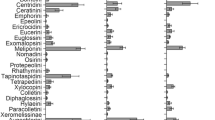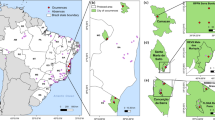Abstract
Australia’s idiosyncratic bee fauna is characterised by a combination of numerous endemic taxa and by the complete absence of some families. Many species, and in particular several oligolectic species, remain undescribed and more than half the named taxa are in need of revision. The main threats to the native bee fauna include removal of nesting and foraging opportunities through land clearing and agriculture, the spread of exotic plant species and the consequences of climate change. Early steps to conserve the native bee fauna include commercial applications, the raising of public awareness and preservation of natural habitat. However, these actions are severely hampered by a lack of both identification keys and taxonomic expertise. Considerable investment in taxonomic research is needed to improve this state of affairs.
Zusammenfassung
Australien besitzt eine einzigartige Bienenfauna, die sich durch einen hohen Anteil an Arten der Familie Colletidae und das Fehlen von Andrenidae und Mellitidae auszeichnet. Aufgrund einer geringen Anzahl an Kolonisierungsereignissen sind viele Linien endemisch. Schätzungsweise 25 % der Arten sind noch unbeschrieben und 50 % der Taxa bedürfen einer Revision. Insbesondere viele oligolektische Arten könnten übersehen worden und aufgrund fehlender Schutzmassnahmen bedroht sein. Des weiteren sind für insgesamt 57 % der Arten keine Bestimmungsschlüssel verfügbar. Dies stellt ein schwerwiegendes Hindernis für Untersuchungen der einheimischen Bienen durch Laien oder Nichtextperten dar. Informationen zum Blütenbesuch und zum Nistverhalten gibt es nur für einige wenige Arten.
Die vielfachen Bedrohungen der einheimischen Bienenfauna beinhaltet die Entfernung von Nistgelegenheiten und Futtersammelstellen, die Ausbreitung eingeführter exotischer Pflanzenarten und Klimaveränderungen. Grossflächige Beseitigungen der natürlichen Vegetation für landwirtschaftliche Zwecke sind zwar im Rückgang, die Veränderungen in der Zusammensetzung der Flora sind jedoch ein Grund zur Sorge. Diese Veränderungen rühren von der Beweidung durch Vieh und andere eingeführte Säugetiere her, sowie durch den Ersatz einheimischer Pflanzen durch eingeführte Unkräuter. Letztere profitieren in ihrer Bestäbung nicht zuletzt von ausgewilderten oder beimkerten Honigbienenvölkern. Die direkte Konkurrenz zwischen einheimischen Bienen und Honigbienen ist vermutlich variabel und abhängig von den jeweils verfügbaren Pflanzen als Nahrungsquellen.
Klimaveränderungen führen zu vermehrten Überschwemmungen und Buschfeuern und haben als langfristige Konsequenz unvorhersehbare Veränderungen in der floralen Abundanz und Phänologie zur Folge. All diese Faktoren beeinflussen mit grosser Wahrscheinlichkeit die Verteilung und Häufigkeit der einheimischen Bienen. Einleitende Schritte zum Schutz der einheimischen Bienenfauna könnten ihre Nutzung als Bestäuber von Nutzpflanzen sein, sowie die Anhebung des öffentlichen Bewusstseins über den Schutz natürlicher Habitate. Der allgemeine Mangel an Kenntnissen über die Taxonomie und das Fehlen von Bestimmungsschlüsseln sind hierin jedoch schwerwiegende Hinderungsgründe. Unsere Fähigkeit des Monitoring und der Beurteilung des Schutzstatus der einheimischen Bienen Australiens erfordert die Ausbildung und die Einstellung von Bienentaxonomen.
Similar content being viewed by others
References
AFD (2006), Cardale J.C. (2001) Updated by Walker K.L. (2006) Hymenoptera: Apoidea, Australian Faunal Directory, Australian Biological Resources Study, Canberra. http://www.environment.gov. au/biodiversity/abrs/online-resources/fauna/afd/ taxa/APOIDEA/checklist (accessed 12 February 2009).
Anderson D. (2006) Improving lucerne pollination with leafcutter bees stage 2, Rural Industries Research and Development Corporation, Canberra. [online] http://www.rirdc.gov.au/ reports/PSE/06-108.pdf (accessed on 30 January 2009).
Auld T.D. (2001) The ecology of the Rutaceae in the Sydney region of south-eastern Australia: poorly known ecology of a neglected family, Cunninghamia 7, 213–239.
Auld T.D., Denham A.J. (2006) How much seed remains in the soil after a fire? Plant Ecol. 187, 15–24.
Bell M.C., Spooner-Hart R.N., Haigh A.M. (2006) Pollination of greenhouse tomatoes by the australian bluebanded bee Amegilla (Zonamegilla) holmesi (Hymenoptera:Apidae), J. Econ. Entomol. 99, 437–442.
Bernhardt P. (1987) A comparison of the diversity, density and foraging behaviour of bees and wasps on Australian Acacia, Ann. Mo. Bot. Gard. 74, 42–50.
Blanche K.R., Ludwig J.A., Cunningham S.A. (2006) Proximity to rainforest enhances pollination and fruit set in orchards, J. Appl. Ecol. 43, 1182–1187.
Bosch J., Kemp W.P. (2002) Developing and establishing bee species as crop pollinators: the example of Osmia spp. (Hymenoptera: Megachilidae) and fruit trees, Bull. Entomol. Res. 92, 3–16.
Bray R.A. (1973) Characteristics of some bees of the family Megachilidae in Southeast Queensland and their potential as alfalfa pollinators, J. Aust. Entomol. Soc. 12, 99–102.
Cork S., Stoneham G., Lowe K. (2007) Ecosystem services and Australian natural resource management (NRM) futures: Paper to the Natural Resource Policies and Programs Committee (NRPPC) and the Natural Resource Management Standing Committee (NRMSC), Australian Government Department of the Environment, Water, Heritage and the Arts, Canberra.
Danforth B.N., Ji S. (2001) Australian Lasioglossum + Homalictus form a monophyletic group: resolving the “Australian Enigma”, Syst. Biol. 50, 268–283.
Danforth B.N., Sipes S., Fang J., Brady S.G. (2006) The history of early bee diversification based on five genes plus morphology, Proc. Natl. Acad. Sci. USA 103, 5118–5123.
Delaplane K.S., Mayer D.F. (2000) Crop pollination by bees, CABI Publishing, New York.
Exley E.M. (1998) New Euryglossa (Euhesma) bees (Hymenoptera: Apoidea: Euryglossinae) associated with the Australian plant genus Eremophila (Myoporaceae), Rec. West. Aust. Mus. 18, 419–437.
Exley E.M. (2004) Revision of the genus Dasyhesma Michener (Apoidea: Colletidae: Euryglossinae), Rec. West. Aust. Mus. 22, 129–146.
Fellendorf M., Mohra C., Paxton R.J. (2004) Devasting effects of river flooding to the ground-nesting bee, Andrena vaga (Hymenoptera: Andrenidae), and its associated fauna, J. Insect Conserv. 8, 311–312.
Gollan J.R., Batley M., Reid C.A.M. (2008) The exotic bee Halictus smaragdulus Vachal, 1895 (Hymenoptera: Halictidae) in the Hunter Valley, N.S.W.: A new genus in Australia, Aust. Entomol. 35, 21–26.
Gordon J., Davis L (2003) Valuing honeybee pollination, Rural Industries Research and Development Corporation, Canberra. [online] http://www.rirdc. gov.au/reports/HBE/03-077.pdf (accessed on 30 January 2009).
Goulson D. (2003) Effects of introduced bees on native ecosystems, Annu. Rev. Ecol. Syst. 34, 1–26.
Goulson D., Derwent L.C. (2004) Synergistic interactions between an exotic honeybee and an exotic weed: pollination of Lantana camara in Australia, Weed Res. 44, 195–202.
Griffin NRM Pty Ltd. (2004) Small steps for nature: A review of progress towards the National Objectives and Targets for Biological Diversity Conservation 2001–2005, WWF Australia and Humane Society International, Sydney.
Heard T.A. (1999) The role of stingless bees in crop pollination, Annu. Rev. Entomol. 44, 183–206.
Hingston A.B., McQuillan P.B. (1998) Does the recently introduced bumblebee Bombus terrestris (Apidae) threaten Australian ecosystems? Aust. J. Ecol. 23, 539–549.
Hingston A.B., McQuillan P.B. (1999) Displacement of Tasmanian native megachilid bees by the recently introduced bumblebee Bombus terrestris (Linaeus, 1758) (Hymenoptera: Apidae), Aust. J. Zool. 47, 59–65.
Hingston A.B., Marsden-Smedley J., Driscoll D.A., Corbett S., Fenton J., Anderson R., Plowman C., Mowling F., Jenkin M., Matsui K., Bonham K.J., Ilowski M., McQuillan P.B., Yaxley B., Reid T., Storey D., Poole L., Mallick S.A., Fitzgerald N., Krirkpatrick J.B., Febey J., Harwood A.G., Michaels K.F., Russell M.J., Black P.G., Emerson L., Visoiu M., Morgan J., Breen S., Gates S., Bantich M.N., Desmachelier J.M. (2002) Extent of invasion of Tasmanian native vegetation by the exotic bumblebee Bombus terrestris (Apoidea: Apidae), Aust. Ecol. 27, 162–172.
Hogendoorn K., Steen Z., Schwarz M.P. (2000) Native Australian carpenter bees as a potential alternative to introducing bumble bees for tomato pollination in greenhouses, J. Apic. Res. 39, 67–74.
Hogendoorn K., Gross C.L., Sedgley M., Keller M.A. (2006) Increased tomato yield through pollination by native Australian Amegilla chlorocyanea (Hymenoptera: Anthophoridae), J. Econ. Entomol. 99, 828–833.
Hogendoorn K., Coventry S.A., Keller M.A. (2007) Foraging behaviour of a blue banded bee, Amegilla (Notomegilla) chlorocyanea Cockerell in greenhouses: implications for use as tomato pollinators, Apidologie 38, 86–92.
Houston T.F. (1977) Nesting biology of three allodapine bees in the subgenus Exoneurella Michener (Hymenoptera: Anthophoridae), Trans. R. Soc. S. Aust. 104, 99–113.
Houston T.F. (1989) Leioproctus bees associated with Western Australian smoke bushes (Conospermum sp.) and their adaptations for foraging and concealment (Hymenoptera: Colletidae: Paracolletini), Rec. West. Aust. Mus. 14, 275–292.
Houston T.F. (1992) Three new, monolectic species of Euryglossa (Euhesma) from Western Australia (Hymenoptera: Colletidae), Rec. West. Aust. Mus. 15, 719–728.
Houston T.F. (1993) Apparent mutualism between Verticordia nitens and V. aurea (Myrtaceae) and their oil-ingesting bee pollinators (Hymenoptera: Colletidae), Aust. J. Bot. 41, 369–380.
Houston T.F. (2000) Native bees on wildflowers in Western Australia. A synopsis of bee visitation of wildflowers based on the bee collection of the Western Australian Museum, Special Publication No. 2, Western Australian Insect Study Society, Perth.
Kremen C., Williams N.M., Bugg R.L., Fay J.P., Thorp R.W. (2004) The area requirements of an ecosystem service: crop pollination by native bee communities in California, Ecol. Lett. 7, 1109–1119.
Kremen C., Williams N.M., Aizen M.A., Gemmill-Herren B., LeBuhn G., Minckley R.L., Packer L., Potts S.G., Roulston T., Steffan-Dewenter I., Vázquez D.P., Winfree R., Adams L., Crone E.E., Greenleaf S.S., Keitt T.H., Klein A.-M., Regetz J., Ricketts T.H. (2007) Pollination and other ecosystem services produced by mobile organisms: a conceptual framework for the effects of land-use change, Ecol. Lett. 10, 299–314.
Lange R.T., Purdie R. (1976) Western myall (Acacia sowdenii) its survival prospects and management needs, Aust. Rangeland J. 1, 64–69.
McDougall K., Kirkpatrick J.B. (1994) Conservation of lowland native grasslands in South-eastern Australia, World Wild Fund for Nature Australia, Sydney.
Matteson K.C., Ascher J.S., Langellotto G.A. (2008) Bee richness and abundance in New York City urban gardens, Ann. Entomol. Soc. Am. 101, 140–150.
Michener C.D. (1965) A classification of the bees of the Australian and South Pacific regions, Bull. Am. Mus. Nat. Hist. 130, 1–362.
Michener C.D. (2000) The bees of the world, John Hopkins University Press, Baltimore.
Morton S.R., Short J., Barker R.D. (1995) Refugia for biological diversity in arid and semi-arid Australia, Paper No. 4, Biodiversity Unit, Australian Government Department of the Environment, Water, Heritage and the Arts, Canberra. [online] http://www.environment. gov.au/publications/series/paper4/index.html (accessed on 30 January 2009).
Murray T.E., Kuhlmann M., Potts S.G. (2009) Conservation ecology of bees: populations, species and communities, Apidologie 40, 211–236.
Paton D.C. (1996) Overview of the feral and managed honeybees of Australia: distribution, abundance, extent of interactions with native biota, evidence of impacts and future research, Australian Nature Conservation Society, Melbourne.
Paini D.R. (2004) Impact of the introduced honey bee (Apis mellifera)(Hymenoptera: Apidae) on native bees: a review, Aust. Ecol. 29, 399–407.
Praz C.J., Müller A., Dorn S. (2008) Specialised bees fail to develop on non-host pollen: do plants chemically protect their pollen? Ecology (Wash. DC) 89, 795–804.
Sattler P., Creighton C. (2002) Australian terrestrial biodiversity assessment 2002, Department of the Environment, Water, Heritage and the Arts, Canberra.
Schwarz M.P., Fuller S., Tierney S.M., Cooper S.J.B. (2006) Molecular phylogenetics of the exoneurine allodapine bees reveal an ancient and puzzling dispersal from Africa to Australia, Syst. Biol. 55, 31–45.
Simpson S.R., Gross C.L., Silberbauer L.X. (2005) Broom and honeybees in Australia: An alien liaison, Plant Biol. 7, 541–8.
Steffan-Dewenter I., Schiele S. (2008) Do resources or natural enemies drive bee population dynamics in fragmented habitats? Ecology 89, 1375–1387.
Stout J., Morales C.L. (2009) Ecological impacts of invasive alien species on bees, Apidologie 40, 388–409.
Tomassi D., Miro A., Higo H.A., Winston M.L. (2004) Bee diversity and abundance in an urban setting, Can. Entomol. 136, 851–869.
Walker K.L. (2008) Carder bee (Afranthidium (Immanthidium) repetitum) pest and diseases image library. [online] http://www.padil.gov.au (accessed 30 January 2009).
Zayed A. (2009) Bee genetics and conservation, Apidologie 40, 237–262.
Zayed A., Packer L., Grixti J.C., Ruz L., Owen R.E., Toro H. (2005) Increased genetic differentiation in a specialist versus a generalist bee: implications for conservation, Conserv. Genet. 6, 1017–1026.
Author information
Authors and Affiliations
Corresponding author
Additional information
Manuscript editor: Mark Brown
Rights and permissions
About this article
Cite this article
Batley, M., Hogendoorn, K. Diversity and conservation status of native Australian bees. Apidologie 40, 347–354 (2009). https://doi.org/10.1051/apido/2009018
Received:
Revised:
Accepted:
Issue Date:
DOI: https://doi.org/10.1051/apido/2009018




